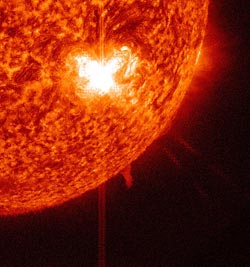Another M-class Flare from Sunspot 1515

The Solar Dynamics Observatory (SDO) captured this image of the sun during an M6.1 flare that peaked at 7:44 AM EDT on July 5, 2012. The image is shown in the 304 Angstrom wavelength, which is typically colorized in red. Credit: NASA/SDO/AIA <br>
Radio blackouts occur when the X-rays or extreme UV light from a flare disturb the layer of Earth's atmosphere known as the ionosphere, through which radio waves travel. The constant changes in the ionosphere change the paths of the radio waves as they move, thus degrading the information they carry.
This affects both high and low frequency radio waves alike. Radio blackouts are rated on a scale from R1 (minor) to R5 (extreme). An R2 radio blackout can result in limited degradation of both high- and low-frequency radio communication and GPS signals.
The same region has also produced numerous coronal mass ejections or CMEs. They have been observed and modeled by NASA's Space Weather Center (SWC) and are thought to be moving relatively slowly, traveling between 300 and 600 miles per second. Since the active region itself is so southerly in the sun, CMEs from this region are generally unlikely to impact Earth.
The strongest flares are classified as X-class, while M-class flares are the second strongest classification. Classified as an M6.1, this latest flare is a little over half the size of the weakest X-class flares.
For more information on flare classification, visit http://www.nasa.gov/mission_pages/sunearth/news/X-class-flares.html.
What is a solar flare? What is a coronal mass ejection?
For answers to these and other space weather questions, please visit the Spaceweather Frequently Asked Questions page.
Karen C. Fox
NASA Goddard Space Flight Center, Greenbelt, MD
Media Contact
All latest news from the category: Physics and Astronomy
This area deals with the fundamental laws and building blocks of nature and how they interact, the properties and the behavior of matter, and research into space and time and their structures.
innovations-report provides in-depth reports and articles on subjects such as astrophysics, laser technologies, nuclear, quantum, particle and solid-state physics, nanotechnologies, planetary research and findings (Mars, Venus) and developments related to the Hubble Telescope.
Newest articles

Recovering phosphorus from sewage sludge ash
Chemical and heat treatment of sewage sludge can recover phosphorus in a process that could help address the problem of diminishing supplies of phosphorus ores. Valuable supplies of phosphorus could…

Efficient, sustainable and cost-effective hybrid energy storage system for modern power grids
EU project HyFlow: Over three years of research, the consortium of the EU project HyFlow has successfully developed a highly efficient, sustainable, and cost-effective hybrid energy storage system (HESS) that…

After 25 years, researchers uncover genetic cause of rare neurological disease
Some families call it a trial of faith. Others just call it a curse. The progressive neurological disease known as spinocerebellar ataxia 4 (SCA4) is a rare condition, but its…





















